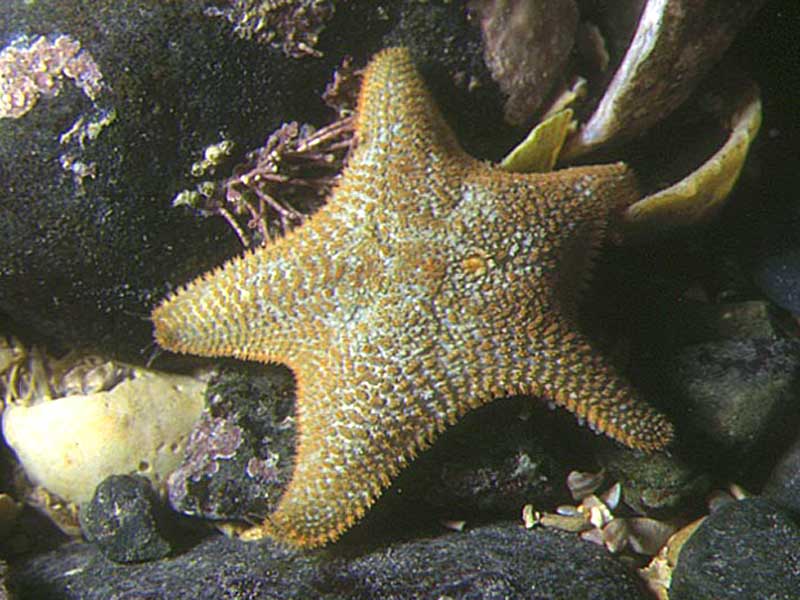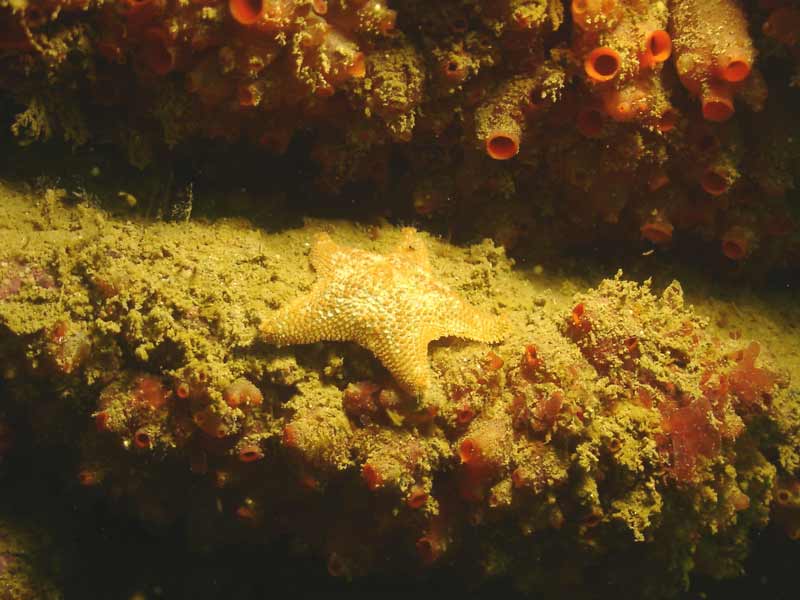A cushion star (Asterina gibbosa)
Distribution data supplied by the Ocean Biodiversity Information System (OBIS). To interrogate UK data visit the NBN Atlas.Map Help
| Researched by | Marie Skewes | Refereed by | Admin |
| Authority | (Pennant, 1777) | ||
| Other common names | - | Synonyms | - |
Summary
Description
Recorded distribution in Britain and Ireland
Common on all British coasts but sparse in the north-east and not recorded from Lincolnshire around to HampshireGlobal distribution
Found in the Mediterranean, Azores and Canary IslesHabitat
Found under boulders and stones on the lower shore on sheltered and semi-exposed rocky coasts and also in rockpools. Extends into the sublittoral to depths of about 100 m.Depth range
-Identifying features
- Sub-pentagonal; ventral surface flat but dorsal surface rounded.
- Mouth plates each bear two spines on the ventral side.
Additional information
Asterina gibbosa is a protandrous hermaphrodite: small or young individuals are males but as they become older and increase in size they develop into females. Asterina gibbosa may be distinguished from the morphologically similar Asterina phylactica which has a consistent colour pattern with a brown central star typically overlying the general background colour. There are rarely spines on the mouth plates of Asterina phylactica.Listed by
- none -
Bibliography
Barnes, R.D., 1980. Invertebrate Zoology, 4th ed. Philadelphia: Holt-Saunders International Editions.
Emson, R.H. & Crump, R.G., 1979. Description of a new species of Asterina (Asteroidea), with an account of its ecology. Journal of the Marine Biological Association of the United Kingdom, 59, 77-94.
Emson, R.H., & Moore, P.G., 1998. Diet and gonad size in three populations of Echinus esculentus. In Proceedings of the Ninth International Echinoderm Conference San Francisco, California, USA, 5-9 August 1996. Echinoderms: San Francisco (ed. R. Mooi & M. Telford), pp. 641-644. Rotterdam: A.A. Balkena.
Esselink, P. & Zwarts, L., 1989. Seasonal trend in burrow depth and tidal variation in feeding activity of Nereis diversicolor. Marine Ecology Progress Series, 56, 243-254.
Fish, J.D. & Fish, S., 1996. A student's guide to the seashore. Cambridge: Cambridge University Press.
Hayward, P., Nelson-Smith, T. & Shields, C. 1996. Collins pocket guide. Sea shore of Britain and northern Europe. London: HarperCollins.
Hayward, P.J. & Ryland, J.S. (ed.) 1995b. Handbook of the marine fauna of North-West Europe. Oxford: Oxford University Press.
Howson, C.M. & Picton, B.E., 1997. The species directory of the marine fauna and flora of the British Isles and surrounding seas. Belfast: Ulster Museum. [Ulster Museum publication, no. 276.]
JNCC (Joint Nature Conservation Committee), 1999. Marine Environment Resource Mapping And Information Database (MERMAID): Marine Nature Conservation Review Survey Database. [on-line] http://www.jncc.gov.uk/mermaid
Mortensen, T.H., 1927. Handbook of the echinoderms of the British Isles. London: Humphrey Milford, Oxford University Press.
Picton, B.E. & Costello, M.J., 1998. BioMar biotope viewer: a guide to marine habitats, fauna and flora of Britain and Ireland. [CD-ROM] Environmental Sciences Unit, Trinity College, Dublin.
Datasets
Centre for Environmental Data and Recording, 2018. Ulster Museum Marine Surveys of Northern Ireland Coastal Waters. Occurrence dataset https://www.nmni.com/CEDaR/CEDaR-Centre-for-Environmental-Data-and-Recording.aspx accessed via NBNAtlas.org on 2018-09-25.
Cofnod – North Wales Environmental Information Service, 2018. Miscellaneous records held on the Cofnod database. Occurrence dataset: https://doi.org/10.15468/hcgqsi accessed via GBIF.org on 2018-09-25.
Fenwick, 2018. Aphotomarine. Occurrence dataset http://www.aphotomarine.com/index.html Accessed via NBNAtlas.org on 2018-10-01
Manx Biological Recording Partnership, 2017. Isle of Man wildlife records from 01/01/2000 to 13/02/2017. Occurrence dataset: https://doi.org/10.15468/mopwow accessed via GBIF.org on 2018-10-01.
Manx Biological Recording Partnership, 2018. Isle of Man historical wildlife records 1995 to 1999. Occurrence dataset: https://doi.org/10.15468/lo2tge accessed via GBIF.org on 2018-10-01.
Manx Biological Recording Partnership, 2022. Isle of Man historical wildlife records 1990 to 1994. Occurrence dataset:https://doi.org/10.15468/aru16v accessed via GBIF.org on 2024-09-27.
National Trust, 2017. National Trust Species Records. Occurrence dataset: https://doi.org/10.15468/opc6g1 accessed via GBIF.org on 2018-10-01.
NBN (National Biodiversity Network) Atlas. Available from: https://www.nbnatlas.org.
OBIS (Ocean Biodiversity Information System), 2025. Global map of species distribution using gridded data. Available from: Ocean Biogeographic Information System. www.iobis.org. Accessed: 2025-08-08
Citation
This review can be cited as:
Last Updated: 24/04/2008








